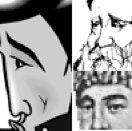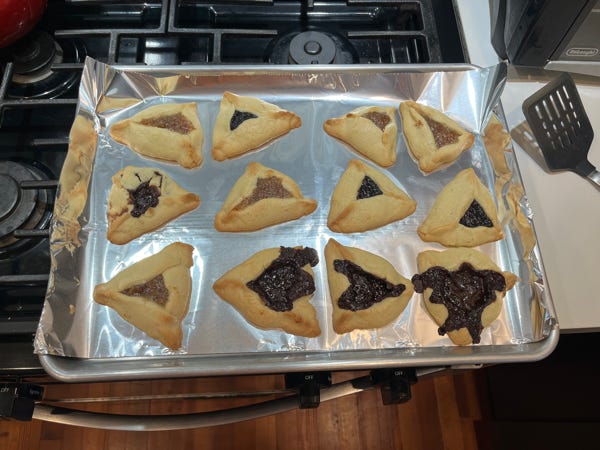Purim is celebrated during the month of Adar, but because this is a leap year in the Jewish calendar, Purim is celebrated in Adar II (beginning this coming Saturday night). When that happens, a minor holiday called Purim Katan (Little Purim) is celebrated in the first month of Adar (February 22-23 this year). There are other Little Purim celebrations around the world, commemorating events that could have been tragic for local Jewish communities, but which were averted. Some of these are named after their location (eg, Purim Narbonne and Purim Rhodes), while others are named after the oppressor in the story (eg, Purim Sebastiano and Purim Burghul). These holidays are generally celebrated with the reading of a Megillah which describes the event, along with festive meals and giving to charity. For example, Purim de los Ladrones (Purim of the Bandits) is celebrated in Gumeldjina, a small city in the Ottoman Empire whose Jewish community was blamed for an attack by rebels from the nearby mountains. Ultimately the Jews proved their innocence and the community was spared. Another Purim Katan celebration is Purim Vinz, which is celebrated with the reading of the Vincent Megillah. What does that holiday commemorate?
Rembrandt - School of - The Feast of Esther Haman’s Disgrace, 1580 by Rembrandt is in the public domain via Wikimedia Commons
A. Cardinal Vincenzo Vannutelli praised Italian dictator Benito Mussolini in 1923, saying that “for his energy and devotion to the country he was chosen to save the nation and restore her fortune.” He was criticized by many for supporting the fascist leader, but his words also prompted some to riot against the Roman Jewish community. Pope Pius XI denounced the Cardinal, however, leading Jewish leaders to declare a Purim Katan at which they thanked the Pope and read the Vincent Megillah.
B. A German-Jewish art collector, Paul Cassirer, presented the first showing of Vincent Van Gogh’s works in Berlin in 1901. The show was vandalized, however, with antisemitic graffiti written on the window of the gallery and paint splashed on some of the artworks. The German leader, Kaiser Wilhelm, was close to the Jews at that time (he later blamed them for his election loss in 1918) and he had the perpetrators arrested. The local Jewish community proclaimed a Purim Katan and wrote a Megillah which they named after the artist.
C. Vincent Ferrer was a Dominican friar in Valencia in the late 1300’s to early 1400’s. During his lifetime, Valencia (and much of Europe) was still recovering from the Black Death, the epidemic of bubonic plague which killed more than 25 million people. An outbreak of violent antisemitism arose in Valencia as those who were still suffering from hunger and economic problems attacked local Jewish residents, destroying businesses and synagogues. Friar Vincent defended the Jewish community, preaching from his church against the hatred and reaching out to King James II of Aragon, who put down the revolt and restored peace and order to the Jewish community. A Purim Katan was declared, with the Vincent Megillah written to thank Friar Vincent for his efforts.
D. In 1614, Vincent Fettmilch, an antisemitic leader of Frankfurt’s bakers guild, led a rebellion against the local city council over financial concerns. The revolt, known as the Fettmilch Uprising, included attacks on the local Jewish community, who the attackers blamed for much of the financial problems. Despite some deaths and the destruction of synagogues and Torah scrolls, Holy Roman Emperor Matthias eventually restored order, leading to the celebration of a Purim Katan with the reading of a Megillah about the event, the Vincent Megillah.
E. A Bensonhurst Jewish community was being oppressed by a local gang called the Sweathogs, under the leadership of a thug named Vincent Barbarino. Because they honored hogs, they did not like the Jews who considered pigs unclean. Barbarino threatened a local Jew, Juan Luis Pedro Felipo de Huevos Epstein, saying “Up your Nose with a Rubber Hose!” This led the leader of the Jewish community, the Kotter Rebbe, to plead with the local authorities for protection, resulting in Mr. Woodman giving Vincent Barbarino a detention, thus saving the Jewish community. The Jews now celebrate Purim Vinz by reading the Vincent Megillah and drawing lots to decide when to hang Vincent Barbarino in effigy, while singing, “Yeah, we’re drawing some lots/Cause we think we’re gonna plotz/Hamentash. Hamentash, Hamentash, Hamentash.”
Click here for the answer.
✡ ✡ ✡ ✡ ✡ ✡ ✡ ✡ ✡





